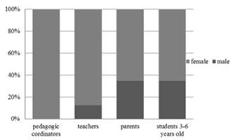Abstract:
Since ancient times, humans and animals have interacted for different purposes. Animal Assisted Therapy (AAT) is used for the assistance and treatment in humans and educational projects where animals are used as co-therapists or co-educators. The use of animals facilitates the process of teaching and learning, and stimulates physical and therapeutic activities. So that knowledge on AAT could be expanded, current study analyzes the opinion of people directly involved in education on AAT implementation as an educational model in early childhood schools in São Paulo, Brazil. Questionnaires were handed out to 10 pedagogical coordinators, 32 teachers, 23 parents and 26 children aged 3-6 years. Results revealed that AAT is not well-known for most interviewees, including pedagogical coordinators, teachers and parents. However, interviewees believe in the benefits of child-pet interactions and are favorable to the implementation of AATs in schools. Projects should be interdisciplinary and must involve professionals from other areas, such as psychologists and veterinarians. Regarding the educational model, interviewees believe in the innovation capacity of AAT and in the possibilities of interdisciplinarity among teachers in the use of animals. Research also demonstrated that children like and support the use of animals in the school.
Index Terms:
Child-pet interaction; child therapy; early childhood education; educational projects

 Thumbnail
Thumbnail
 Thumbnail
Thumbnail
 Thumbnail
Thumbnail
 Thumbnail
Thumbnail
 Thumbnail
Thumbnail
 Thumbnail
Thumbnail





